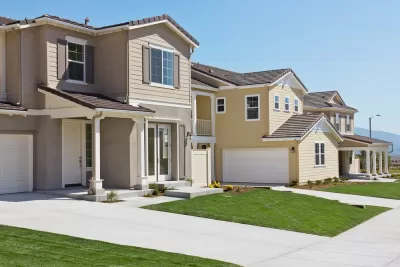Once scratchy and unrealistic, artificial grass has come a long way. Now, it’s quickly becoming a popular lawn replacement as droughts and climate change make traditional lawns harder to maintain.

Writing in Bloomberg CityLab, Brian Eckhouse and Siobhan Wagner describe the movement to replace suburban grass lawns with artificial turf in cities facing worsening drought and water restrictions. “Within the next 30 years, droughts may impact three quarters of the world’s population. While plastic turf poses its own climate challenges, it’s increasingly seen as a viable alternative to real green yards that devour precious water.”
Homeowners are taking notice. “For some, it’s the cash-for-grass rebates being offered by local water agencies. For others, it’s the realization that the classic lawn is increasingly unsustainable in a time of megadrought. And then there are the residents coaxed into the shift by the water notices or fines.”
Critics of artificial turf say some types, made of recycled tires, can leach chemicals into the ground and waterways. “The most obvious environmental problem with artificial grass is it’s rooted in the biggest climate nemesis of all: fossil fuel. Synthetic turf is made from a stew of petroleum-based components, making it nearly impossible to recycle. At the end of an artificial lawn’s useful life, which is about 15 years, it will likely go to a landfill or be incinerated.”
Comparing the products to plastic water bottles, “Stefan Diderich, director general of the EMEA Synthetic Turf Council, an artificial grass industry group, says companies are trying to develop a more widely recyclable turf made from a single material like polyester.”
As climate change shifts weather patterns around the world, “The future for lawns is in question everywhere. Even in the UK—a country synonymous with rain—lawn owners are accepting shades of yellow and brown amid green.”
FULL STORY: The Suburban Lawn Will Never Be the Same

Alabama: Trump Terminates Settlements for Black Communities Harmed By Raw Sewage
Trump deemed the landmark civil rights agreement “illegal DEI and environmental justice policy.”

Planetizen Federal Action Tracker
A weekly monitor of how Trump’s orders and actions are impacting planners and planning in America.

The 120 Year Old Tiny Home Villages That Sheltered San Francisco’s Earthquake Refugees
More than a century ago, San Francisco mobilized to house thousands of residents displaced by the 1906 earthquake. Could their strategy offer a model for the present?

Ken Jennings Launches Transit Web Series
The Jeopardy champ wants you to ride public transit.

BLM To Rescind Public Lands Rule
The change will downgrade conservation, once again putting federal land at risk for mining and other extractive uses.

Indy Neighborhood Group Builds Temporary Multi-Use Path
Community members, aided in part by funding from the city, repurposed a vehicle lane to create a protected bike and pedestrian path for the summer season.
Urban Design for Planners 1: Software Tools
This six-course series explores essential urban design concepts using open source software and equips planners with the tools they need to participate fully in the urban design process.
Planning for Universal Design
Learn the tools for implementing Universal Design in planning regulations.
Clanton & Associates, Inc.
Jessamine County Fiscal Court
Institute for Housing and Urban Development Studies (IHS)
City of Grandview
Harvard GSD Executive Education
Toledo-Lucas County Plan Commissions
Salt Lake City
NYU Wagner Graduate School of Public Service




























